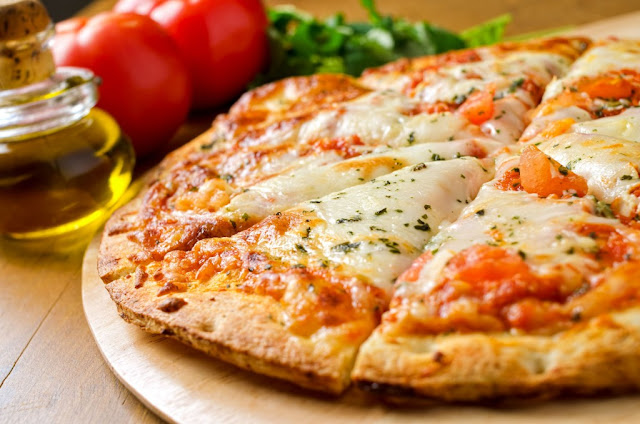Spare us the lumpy chain monstrosities and “everything-on-it” wheels of greed.
The best pizza was and still is the simple Neapolitan, an invention now protected by its own trade association that insists on sea salt, high-grade wheat flour, the use of only three types of fresh tomatoes, hand-rolled dough and the strict use of a wood-fired oven, among other quality stipulations.
With just a few ingredients -- dough, tomatoes, olive oil, salt and basil (the marinara pizza does not even contain cheese) -- the Neapolitans created a food that few make properly, but everyone enjoys thoroughly.
Neapolitan pizza, or pizza Napolatena, is a type of pizza that originated in Naples, Italy. Neapolitan pizza is made from simple and fresh ingredients: a basic dough, raw tomatoes, fresh mozzarella cheese, fresh basil, and olive oil -- no fancy toppings. One of its defining characteristics is that there is often more sauce than cheese, leaving the middle of the pie wet or soggy and not conducive to being served by the slice. Because of this, Neapolitan pizzas are generally pretty small (about 10-12 inches), making them closer to the size of a personal pizza. Neapolitan pizzas are cooked at very high temperatures (800°F-900°F) for no more than 90 seconds.
History of Neapolitan Pizza
Pizza as we know it today (dough topped with tomatoes and cheese) was invented in Naples, Italy. Before the 1700s, flatbreads existed but were never topped with tomatoes — now a defining characteristic of pizza. Tomatoes were brought to Europe in the 16th century by explorers returning from Peru, but they were believed to be poisonous by many Europeans until poor peasants in Naples began to top their flatbread with it in the late 18th century.
The dish soon became popular, with visitors to Naples seeking out the poorer neighborhoods to try the local specialty.
Marinara pizza, which does not have cheese, is so named because it was traditionally prepared by “la marinara,” the seaman's wife, for her husband when he returned from fishing trips in the Bay of Naples.”
Baker Raffaele Esposito, who worked at the Naples pizzeria “Pietro... e basta così,” is generally credited with creating Margherita pizza, now known as the classic Neapolitan-style pizza. In 1889 , King Umberto I and Queen Margherita of Savoy visited Naples and Esposito baked them a pizza named in honor of the queen whose colors mirrored those of the Italian flag: red (tomatoes), white (mozzarella), and green (basil leaves).
Official Certification
The Associazione Verace Pizza Napoletana (VPN) was founded in 1984 in Naples, Italy, to certify pizzerias that use the proper ancient artisan traditions of authentic Neapolitan pizza. They have several requirements (see below) that must be met to gain certification, which must be applied for by a restaurant. They now also have an American branch and there are currently a few hundred restaurants in Italy and around the world that are VPN certified.
Authentic Neapolitan Pizza Requirements
An authentic Neapolitan pizza has a crust made from a dough that is made with highly-refined Italian type 0 or 00 wheat flour (read more about flour types), Neapolitan or fresh brewer’s yeast (not dry yeast), water, and salt. The dough must be kneaded by hand or with a low-speed mixer and formed by hand, without the help of a rolling pin. The dough is topped with raw, pureed San Marzano tomatoesfrom Italy; fior di latte, which is mozzarella cheese made from cow’s milk, or mozzarella di Bufala, which is mozzarella cheese made from the milk of water buffalos, usually raised in the Campania and Lazio marshlands in Italy; fresh basil, and extra-virgin olive oil. The ingredients must be all-natural and fresh. The pizza is baked for 60–90 seconds (baking time cannot exceed 90 seconds) in a minimum 800°F stone oven with a wood fire.
Neapolitan Pizza Variations
There are three official variants:
• Pizza Marinara, which is topped with tomato, garlic, oregano and extra- virgin olive oil.
• Pizza Margherita, which is topped with tomato, sliced fresh mozzarella, fresh basil and extra-virgin olive oil.
• Pizza Margherita Extra, which is topped with tomato, sliced mozzarella di Bufala, fresh basil and extra-virgin olive oil.
• Pizza Marinara, which is topped with tomato, garlic, oregano and extra- virgin olive oil.
• Pizza Margherita, which is topped with tomato, sliced fresh mozzarella, fresh basil and extra-virgin olive oil.
• Pizza Margherita Extra, which is topped with tomato, sliced mozzarella di Bufala, fresh basil and extra-virgin olive oil.
Neapolitan-Style Pizza
There are many restaurants and pizzerias that make Neapolitan-style pizza that does not adhere to the strict rules of the VPN association or that are simply just not certified because they never applied. Neapolitan-style pizza typically consists of a thin and soft crust (if it is cooked properly at a high temperature the crust will bubble up and be charred in spots) that is topped with a simple tomato sauce, fresh mozzarella cheese, and fresh basil. You can even make it at home with this Neapolitan Pizza Recipe.





0 comments:
Post a Comment